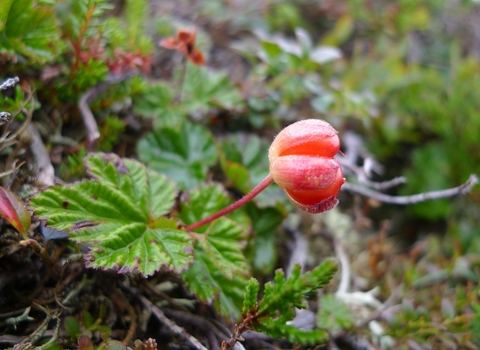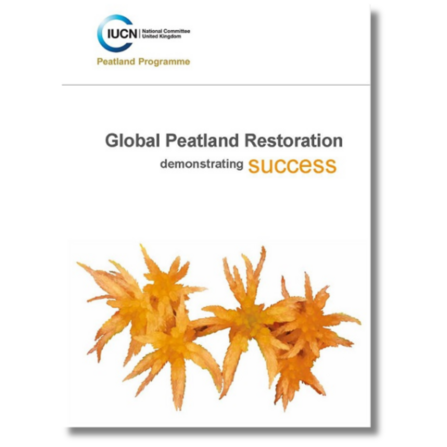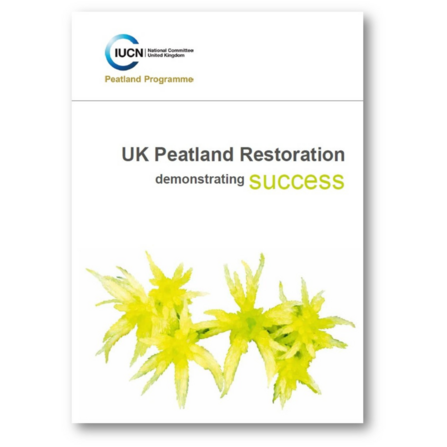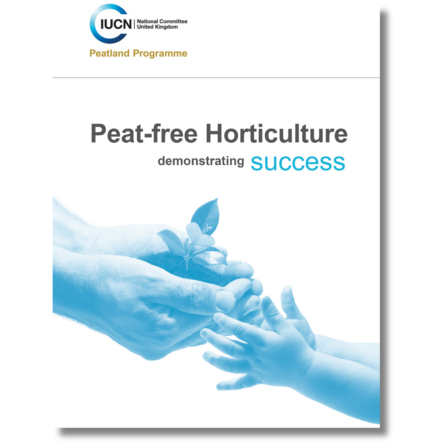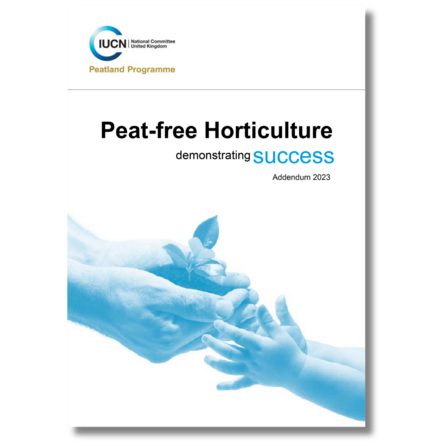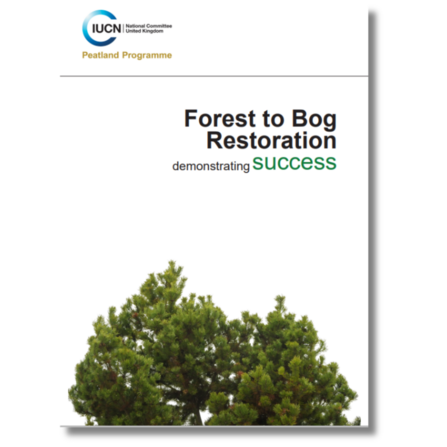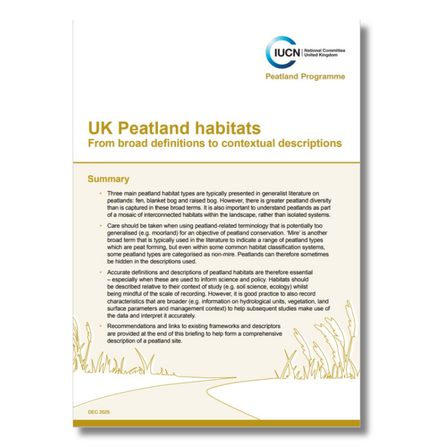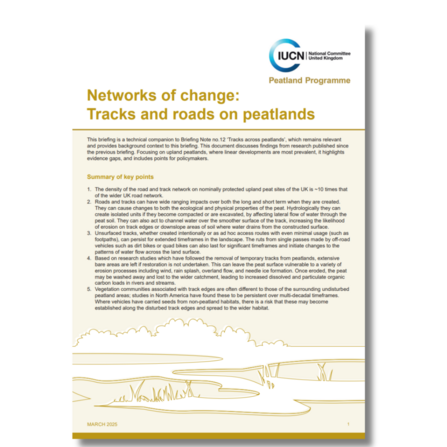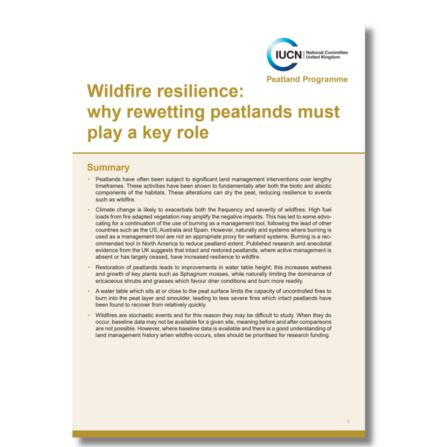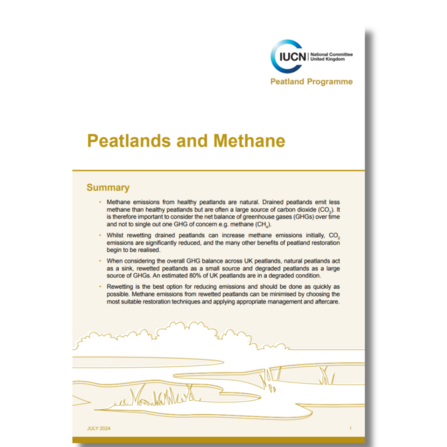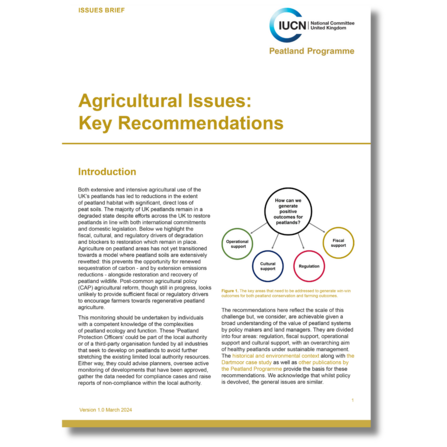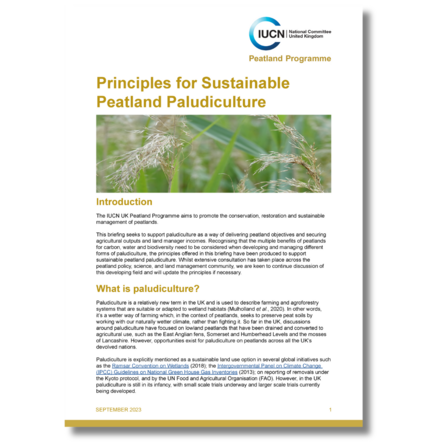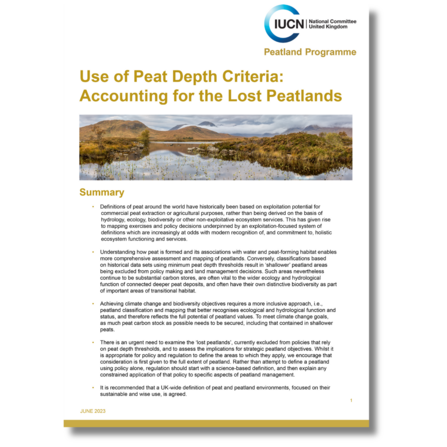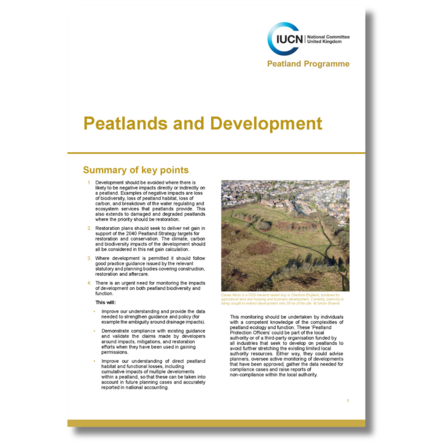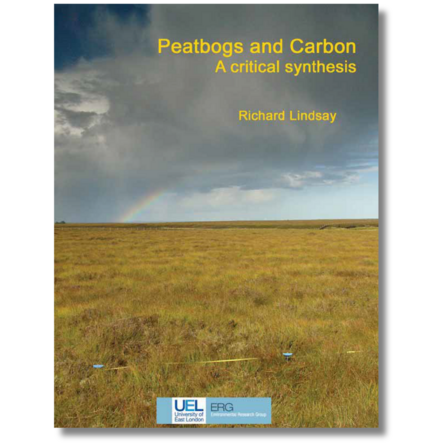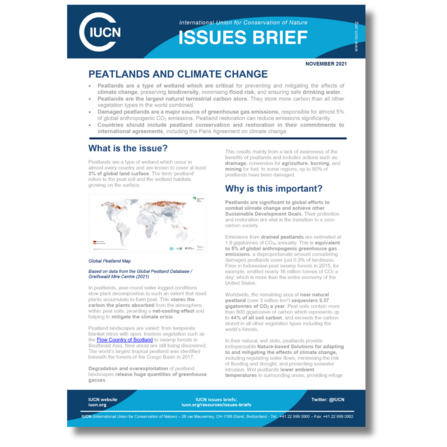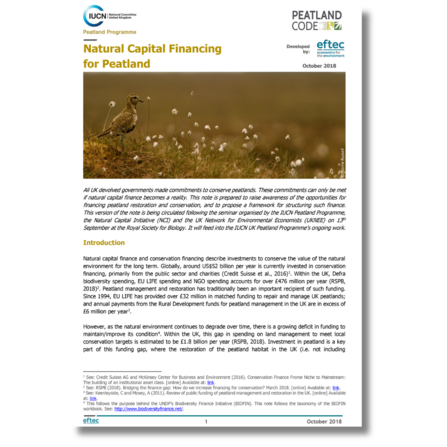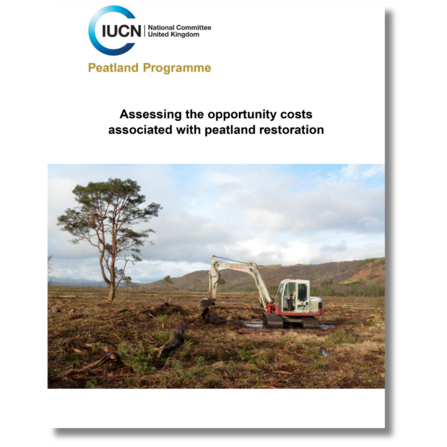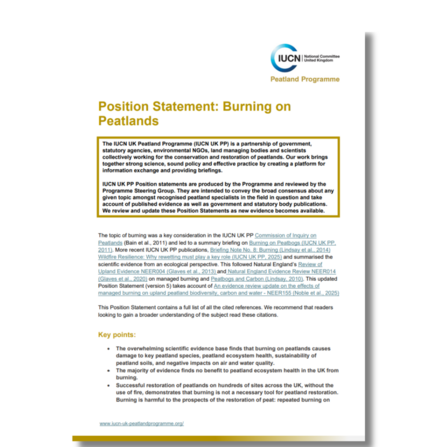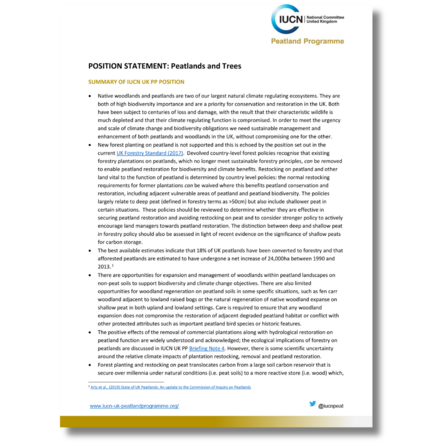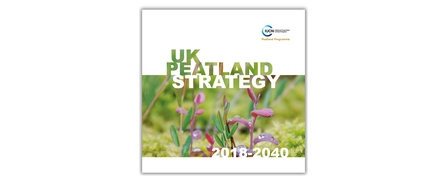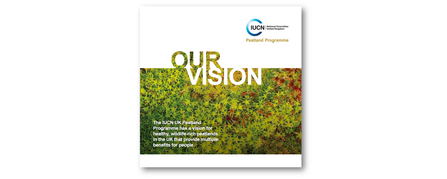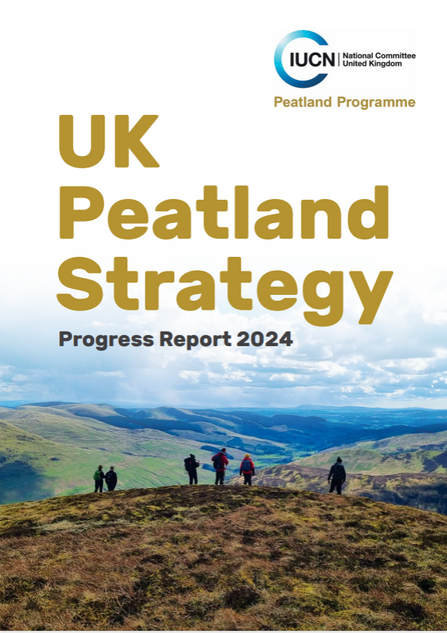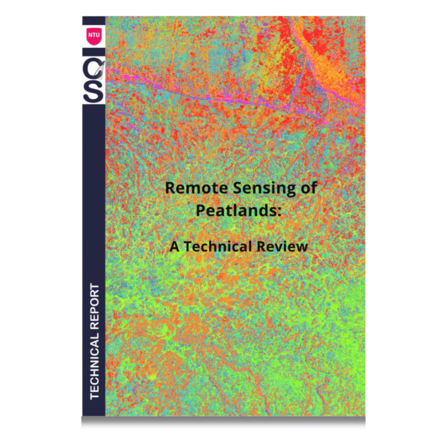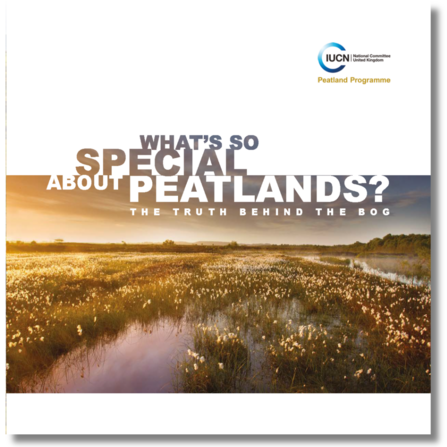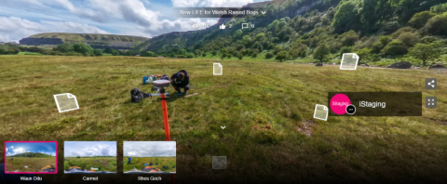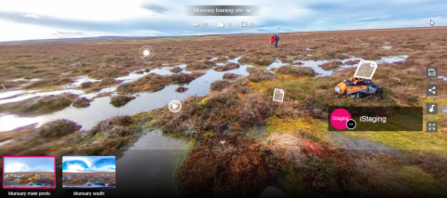The IUCN UK Peatland Programme exists to promote peatland restoration in the UK and advocates the multiple benefits of peatlands through partnerships, strong science, sound policy and effective practice. The resources created by our partnership encapsulate these principles and aim to provide accessible introductions to peatland science, practice and policy. Each of the resources are written with different audiences in mind and, therefore, some may be more accessible or more technical. They are all freely available to use and share. If you would like more information about our resources or have suggestions for content you would like to see, please contact info@iucn.org.uk.
Demonstrating Success publication series
Our ‘Demonstrating Success’ publication series showcases successful peatland restoration projects and examples of good practice from across the UK and internationally. Using multiple case studies, we illustrate opportunities for restoration and sustainable management, as well as innovative ways of engaging people in conservation action and preventing unsustainable activities.
‘Global Peatland Restoration – Demonstrating Success’, from the Peatland Programme and CEM Thematic Group on Peatlands, showcases successful restoration projects across the world.
A selection of case studies from the UK have been brought together in ‘UK Peatland Restoration – Demonstrating Success’ to showcase the delivery of peatland restoration and share learning.
'Peat-free Horticulture – Demonstrating Success' showcases examples of organisations who have demonstrated the high-quality results that can be achieved without the use of peat in horticulture.
Due to the wealth of recent advances in the shift to peat-free horticulture, the original document above has been supplemented with an addendum.
'Forest to Bog Restoration - Demonstrating Success' examines how the practice of forest to bog restoration has advanced significantly, thanks to the collaborative nature of the restoration community.
Policy briefings
Our briefings address various aspects of the topic of peatlands. We identify existing knowledge gaps and provide recommendations for policy makers, practitioners and businesses for supporting a sustainable future for peatlands.
UK Peatland habitats: From broad definitions to contextual descriptions explores the challenges of describing UK peatland habitats and the need for precise terminology and comprehensive site descriptions.
'Networks of change: Tracks and roads on peatlands', is a technical companion to Briefing Note no.12 ‘Tracks across peatlands’, focusing on upland peatlands, and includes points for policymakers.
'Wildfire resilience: why rewetting peatlands must play a key role', explores recent evidence demonstrating the importance of peatland restoration in increasing resilience to wildfire.
‘Peatlands and Methane’, discusses the natural processes that lead to methane production and compares greenhouse gas emissions from intact, drained, and rewetted peatlands.
There are currently challenges in reaching mutually beneficial outcomes for peatlands and agriculture. Agricultural Issues: Key Recommendations shows how these challenges can be addressed.
‘Principles for Sustainable Peatland Paludiculture’, details how multiple benefits of peatlands can be realised when transitioning to paludiculture as a sustainable management practice.
'Use of Peat Depth Criteria: Accounting for the Lost Peatlands' explores the context of depth-based definitions, and emphasises the importance of shallow peat in supporting wider ecosystem function.
'Peatlands and Development' details the need for monitoring the impacts of development on both biodiversity and function and outlines recommendations for development on peatlands.
'Supporting Sustainable and Healthy Peatlands After Brexit' identifies ten key elements to ensure that the UK continues to deliver healthy peatlands and avoids the huge costs to society of degraded and damaged peatlands post-Brexit.
Scientific briefings
Our briefings address various aspects of the topic of peatlands. We identify existing knowledge gaps and provide recommendations for policy makers, practitioners and businesses for supporting a sustainable future for peatlands.
'Peatbogs and Carbon: a critical synthesis' looks to inform policy development in peat bog conservation and restoration in the context of climate change.
The 'Peatlands and Climate Change' Issues Brief from the International Union for Conservation of Nature (IUCN) explores the global issues facing peatlands and what can be done to address them.
-
'Peat Bog Ecosystems: Key Definitions' looks at the definition of peatlands and peat, how they form, how to classify different peatland types and the consequences of definitional confusions. This briefing was produced alongside two videos: 'The Extraordinary Story of Carbon and Peat' and 'Raised Bog Formation'.
-
'Peat Bog Ecosystems: Structure, Form, State and Condition' examines the ecological complexity of peatlands and the importance of microtopography and accurate habitat assessment in understanding bog habitat condition.
-
'Weathering, Erosion and Mass Movement of Blanket Bog' looks at the relationship between erosion and peatlands, the effects on carbon emissions and regeneration and restoration of eroded peatlands.
-
'Peat Bogs, Climate and Climate Change' explores the effects of climate change on peatlands and their resilience to changes in rainfall.
-
'Peatland Restoration' focuses on how stabilisation is required to prevent further degradation of peatlands, following which restoration can focus on the recovery of the ecosystem.
-
'Atmospheric Pollution' looks at the damage to peatlands by deposition of pollutants from the atmosphere such as acid rain and the practical action that can be taken to reduce the impacts.
-
'Impacts of Artificial Drainage on Peatlands' examines the impacts of drainage on the ecology, hydrology and carbon sequestration of peatlands, and how we can reverse them. This briefing was produced alongside two videos: 'Explaining the Impacts of Draining Peatland on Carbon Emissions, Hydrology and Peat Structure' and 'Drainage Impacts on a Raised Bog'.
-
'Ecological Impacts of Forestry on Peatlands' looks at afforestation of peatlands through plantation forestry, and how to reverse the negative impacts.
-
'Domestic Peat Extraction' documents the history and impacts of peat extraction for domestic use and identifies the gaps that we have in our knowledge.
-
'Commercial Peat Extraction' explores the purposes for commercial peat extraction, the impacts this has on peatlands and how we can restore affected areas.
-
'Grazing and Trampling' looks at what benefits peatland ecosystems and what damages them, including the impacts of unsustainable practices.
-
'Burning' examines the role of fire in bog ecosystems and the impacts of burning management. This briefing was produced alongside two videos: 'Burning on Blanket Bogs: Part 1 - Effects of Fire' and 'Burning on Blanket Bogs - Part 2: Recovery Pathways'.
-
'Tracks Across Peatlands' details the challenge of creating regular access routes across peatlands, the different types of track that can be used and their impacts, and how to minimise those impacts.
Natural Capital briefings
Our briefings address various aspects of the topic of peatlands. We identify existing knowledge gaps and provide recommendations for policy makers, practitioners and businesses for supporting a sustainable future for peatlands.
'Natural Capital Financing for Peatland' aims to raise awareness of the opportunities for financing peatland restoration and conservation, and proposes a framework for structuring such finance.
'Assessing the Opportunity Costs Associated with Peatland Restoration' aims to reflect evolving understanding of the issues surrounding opportunity costs in relation to peatland restoration.
Position Statements
Our position statements outline the Peatland Programme’s views on peatland issues where scientific and policy consensus has not yet been clearly established. We aim to synthesise the scientific evidence base and draw conclusions based on existing knowledge, updating these statements as additional evidence emerges.
'Position Statement: Peatlands and Trees' summarises the scientific evidence on the impact of trees and their removal from peatlands and sets out current forestry policy relating to peatlands and peatland restoration.
UK Peatland Strategy publications
The UK Peatland Strategy aims to drive and co-ordinate action across the UK, supported by country level plans.
The UK Peatland Strategy Progress Report 2024 summarises progress against the goals of the UK Peatland Strategy.
Commission of Inquiry on Peatlands
The Commission of Inquiry on Peatlands was set up to produce an authoritative set of reports assessing the science on key areas of relevance to policy makers. It brings together experts in science, policy and practice to carry out a thorough review of key peatland issues and a deliver clear scientific consensus about peatland restoration, particularly in relation to climate change, biodiversity and ecosystem services.
You can find out more and access the reports on our Commission of Inquiry webpage.
Technical guidance
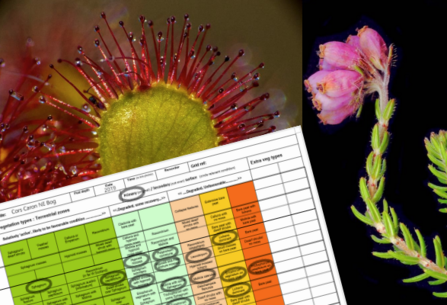
The Peat Bog Condition Matrix
The peat bog condition matrix has been designed to supplement the JNCC Common Standards Monitoring scheme for raised bog and blanket bog. It provides a simple ‘traffic light’ approach to indicating the condition of the various identifiable sectors of ground that collectively make up a raised bog or blanket bog. The condition matrix is also designed to reveal, on repeat survey, changes (good or bad) to that condition-state in a readily understood way.
Download the Peat Bog Condition Matrix Manual, which includes an Excel matrix to quadrat convertor designed by Jack Cook at Aberystwyth University. Please note, the Excel convertor is licensed under the Creative Commons Attribution Non-Commercial 4.0 International License (CC BY-NC 4.0) for non-commercial use only. View the license terms.
Remote Sensing of Peatlands is a technical review of the potential, and applicability, of remote sensing technologies for ecological monitoring of UK peatlands.
The review aims to act as a summary and reference document for peatland restoration practitioners, which outlines a range of specific metrics required for peatland assessment and assesses whether existing remote sensing technologies are applicable. It is also intended to provide background information for: landowners prior to judging capabilities and specifying services to be contracted; those undertaking their own 'in-house' survey work, and contractors offering services.
The document provides an introduction to optical mapping of land cover and the components of remote sensing; mapping peatland typography and physical features from elevation data; burn mapping, and potential future applications of remote sensing technologies.
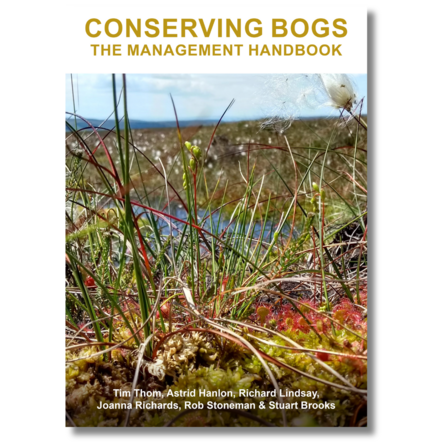
Conserving Bogs: The Management Handbook is a practical manual of methods and techniques to help people effectively manage and conserve bogs. This edition has been updated to reflect advances and evolution in both understanding and techniques. The ambition is for this resource to evolve with a clear process set out to submit revisions or additions to the text including where restoration good practice is currently evolving at some pace e.g. forest-to-bog restoration.
Should you wish to recommend any additions to ‘Conserving Bogs: The Management Handbook’ please contact info@iucn.org.uk. Additions will be at the discretion of the authors and the IUCN UK Peatland Programme.
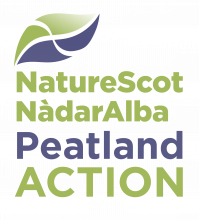
The Peatland ACTION Technical Compendium provides an overview of the procedural and technical requirements for peatland restoration in Scotland, alongside an introduction to the types of restoration interventions that have been applied to date by Peatland ACTION, since its inception in 2012, in applying peatland restoration techniques and assessing their outcomes.
The compendium identifies ‘families’ of techniques with shared restoration objectives and describes best practices associated with individual techniques, conditions of applications, machinery requirement, intended outcomes and practical issues likely to impact on success.
A brief overview of the basic principles of restoration of peatland hydrology is also provided to help explain the impacts, and aims, of the various restoration techniques on the water table.
The information gathered here comes from the experiences of Peatland ACTION, with the intention that the document will be kept up to date throughout the government ambition to accelerate and transform design and delivery of peatland restoration in Scotland. This version was produced in November 2022.
For further information please contact the Peatland ACTION team at peatlandaction@nature.scot.
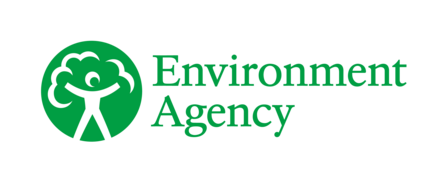
Eco-hydrological Guidelines for Blanket Bog
All countries of the UK have ambitious targets for the restoration of degraded peatland. The development of Ecohydrological Guidelines for Blanket Bog and Associated Habitats is seen as an important element of any strategy that aims to restore degraded ombrogenous mires (those formed under the exclusive influence of precipitation), which are particularly widespread in upland areas in the UK.
Based on ‘Wetland Framework’ for lowland mires (Wheeler, Shaw and Tanner 2009), the project aims to determine the availability of, and then to collate, ecological and hydro-geological data sources for individual mire sites so that they can be used for a ‘bottom-up’ analysis. This would provide the foundation for a robust upland mire habitat classification, to provide a holistic understanding of the habitat requirements of upland mire vegetation types, and to provide a basis for assessing the likely outcomes of conservation actions.
This is an on-going project which was initiated by the UK Technical Advisory Group Wetland Task team and is being led by the Environment Agency, in partnership with Scottish Environmental Protection Agency, Natural Resources Wales, Natural England, DAERA-Northern Ireland, and NatureScot.
Two phases have been completed so far:
Phase 1: a desk-based scoping study to review information that could be used to characterise the water supply mechanisms of a range of blanket mires, and to understand how these relate to the different vegetation types found in blanket mire landscapes.
Annexes 1 (Reference Sites) and 2 (Classification of upland peat soils)
Phase 2: a pilot study of a limited range of contrasting regions in England and Wales where ‘blanket bog’ is extensive (the Roman Wall Country of Northumberland and Cumbria, Forest of Bowland, Southern Pennines, and locations in central and northern Wales) using the Wetland Framework approach to characterise the range of habitats and topographical conditions associated with the vegetation types and peat surfaces found in blanket mire landscapes.
Based on the outcomes of this initial work, the next phase is to apply the same approach to gather ecohydrological information from other regions of the UK to develop a set of eco-hydrological guidelines which can be applied to all areas of the UK. It will be particularly important to include representative examples of blanket mire landscapes from all UK regions in future phases of the project.
For further information please contact the EA Peatland Team at: Emma.Taylor@environment-agency.gov.uk

Data Exchange Standard for Peat Surveys
Peat data is collected by many organisations around the world, for a variety of reasons, including monitoring and restoration efforts, but also for development or archaeological work. Currently, there is no widely adopted data standard. Peat surveys are conducted with various methodologies, and data is recorded in different formats. This makes it difficult to integrate different datasets for use in large scale analyses.
Part of Natural England's England Peat Map project, the current draft version of the Data Exchange Standard covers peat depth surveys. Future versions are intended to incorporate further peat survey types, for example, surface features such as grips, gullies and haggs and bare peat. Find out more about the Data Exchange Standard in Natural England's blog.
Please send any comments on the Data Exchange Standard to peatmap@naturalengland.org.uk.
Training courses
Education is key to advancing the restoration and protection of the UK's peatlands. Embedding awareness and appreciation of these habitats in informal and formal education not only helps to share the importance of our peatlands with a broad audience, but also aims to inspire future peatland managers and conservationists. For those already engaged in the sector, training is an essential part of ensuring peatlands are accurately assessed and that restoration activities are carried out to the highest standards.
If you have any training or education resources you would like to feature on our website, please contact info@iucn.org.uk.
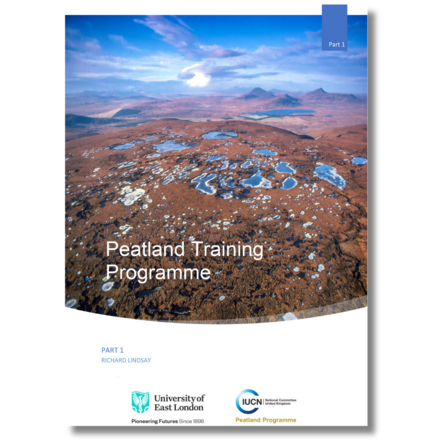
Part 1 of the Peatland Training Programme introduces key peatland concepts, the implications of these for peatland policy, and more in-depth information on selected topics. Whilst it does not seek to be comprehensive in terms of addressing all aspects of peatland science, policy and practice, it does aim to focus on key issues relevant to the UK while also offering insights into wider European and global perspectives.
The training programme consists of published documents, slides and 3D animations that are almost all accessible through the University of East London Open Access Repository, specifically within Richard Lindsay’s area, or via the IUCN UK Peatland Programme website. Unfortunately, since the resources were published, Springer has chosen to hide the main content for many links behind a paywall, leaving only the summaries freely available. Richard is therefore working to create replacements for these items and the document will be updated as these materials become available.
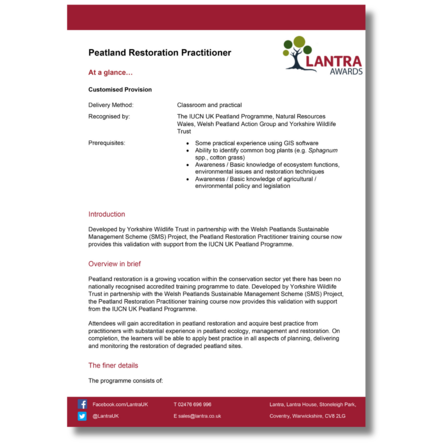
Peatland restoration is a growing vocation within the conservation sector yet there has been no nationally recognised accredited training programme to date. Developed by Yorkshire Wildlife Trust in partnership with the Welsh Peatlands Sustainable Management Scheme (SMS) Project, the Peatland Restoration Practitioner training course now provides this validation with support from the IUCN UK Peatland Programme.
The Peatland Restoration Practitioner course is for those who are interested in and motivated by managing and conserving peatlands, such as land managers and restoration officers who would like to develop or diversify their skillset in peatland restoration and management, or peatland restoration practitioners who would like to gain formal proof of competence in peatland restoration and management.
Attendees will gain accreditation in peatland restoration and acquire best practice from practitioners with substantial experience in peatland ecology, management and restoration. On completion, learners will be able to apply best practice in all aspects of planning, delivering and monitoring the restoration of degraded peatland sites.
The programme consists of 8 topics covered over 2 separate 3-day sessions. Part 1 focuses on the preparation phase required before conducting peatland restoration. Part 2 focuses on the delivery phase of restoration. If you would like to attend, please register your interest with peat.training@yppartnership.org.uk.
Education resources
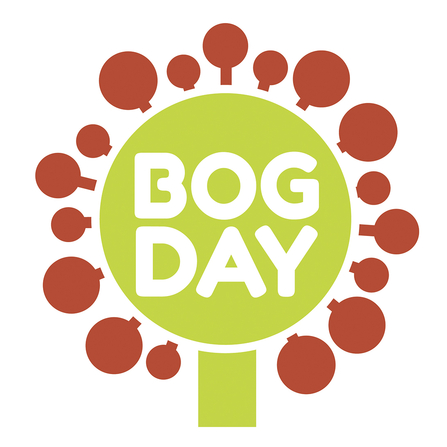
We have a range of education materials available for a range of ages on our Bog Day pages to help people understand why bogs are special.
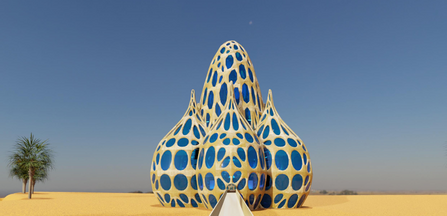
Explore the world’s peatlands from the comfort of your own home with the Virtual Peatland Pavilions. They contain 3D tours with a wealth of inspiring peatland materials from around the world in a variety of formats to suit everyone.
Videos
You can find all of our videos on our YouTube channel but a selection of key educational videos are provided here.
The following are part of a suite of training materials produced by Richard Lindsay, University of East London, and the IUCN UK Peatland Programme, working in partnership for peatlands:
The Extraordinary Story of Peat and Carbon (https://youtu.be/L4fdLWnhDqU)
The Extraordinary Story of Peat and Carbon: A short animation that looks at the extraordinary quantities of carbon locked up over millennial timescales within peatland ecosystems.
Raised bog formation video (https://youtu.be/_CCMngoQdos)
Raised Bog Formation: An animation showing how raised bogs are formed.
Drainage impacts on a raised bog video (https://youtu.be/PQ7VoqXxw7U)
Drainage Impacts on a Raised Bog: This animation explores the hydrological basis of raised bogs, considers what happens to them when they are damaged by drainage, peat cutting or agricultural land-claim, and suggests ways to aid and speed up recovery from such impacts.
For more information about the growth of raised bogs and their behaviour as ground water mounds, visit the DigiBog website.
Burning on Blanket Bogs: Part 1- Effects of fire video (https://youtu.be/nzsr5A4VhZU)
Burning on Blanket Bogs: Part 1 - Effects of Fire: This animation is based largely on evidence from the experimental plots established on blanket bog at Hard Hill, Moor House National Nature Reserve, in 1954. Most of the images of actual sites used in the animation are from Hard Hill or from other areas of blanket bog subject to managed burning. Three of the images used are from examples of wildfire.
Burning on Blanket Bogs: Part 2 - Recovery pathways video (https://youtu.be/pAAkBwhtNNQ)
Burning on Blanket Bogs: Part 2 - Recovery Pathways: Demonstrating the differing pathways of recovery that may be observed, or stimulated, following cessation of burning on damaged blanket mire habitat. These animations are based largely on evidence from the experimental plots established on blanket bog at Hard Hill, Moor House National Nature Reserve, in 1954. Most of the images of actual sites used in the animation are from Hard Hill or from other areas of blanket bog subject to managed burning. Three of the images used are from examples of wildfire. References are available at the end of the video.
Explaining the Impacts of Draining Peatland on Carbon Emissions, Hydrology and Peat Structure: The effect of peatland drainage on surface subsidence and carbon loss continues as long as drainage persists. Peatland restoration, particularly including drain blocking, is needed to halt this loss and restore healthy functioning peatlands. Measuring ground-level movements (subsidence) as well as the behaviour of the water table is vital to understand the condition of a peatland.
Some other video highlights:
The Carbon Farmer video (https://vimeo.com/303463841)
The Carbon Farmer: from The Top Of The Tree. In their current state the UK’s peatlands are a source of around 20 million tonnes of CO2 (equivalent) per year – this is the same as the yearly emissions from electricity use in two and a half million homes. This short film premiers possibilities for achieving a brighter carbon future.
The Day We Found The Bog video (https://youtu.be/LKvxEls4wRs)
The Day We Found The Bog: This was released for Bog Day - an international celebration of the importance of bogs, fens, swamps and marshes on the 4th Sunday of each July.
VR
360 Virtual Reality (VR) and 3D views can be used to generate useful descriptions of peatland sites.
A combination of panoramas have been created to help train peatland staff to recognise key peatland characteristics.
The 3D - VR - 360 videos are also a great way of bringing the outdoors into the classroom, office or home - helping people to explore and become familiar with peatlands without having to venture outside. Click on the information hotspots which are scattered across the VR panoramas to learn more about peatland characteristics.
These videos are intended to be viewed on a smartphone with VR goggles (widely available). See viewing instructions and QR codes.
There are more 360 degree panoromas and VR imagery not listed here, including Hard Hill Research Plots, Moor House National Nature Reserve.
Courtesy of Richard Lindsay, University of East London.
Conference series
Our annual conference series provides a unique convening function for the UK peatland community which celebrates these unique and precious habitats. Please see the content (workshop session recordings, posters, summaries) from our past conferences on our conference series page.

